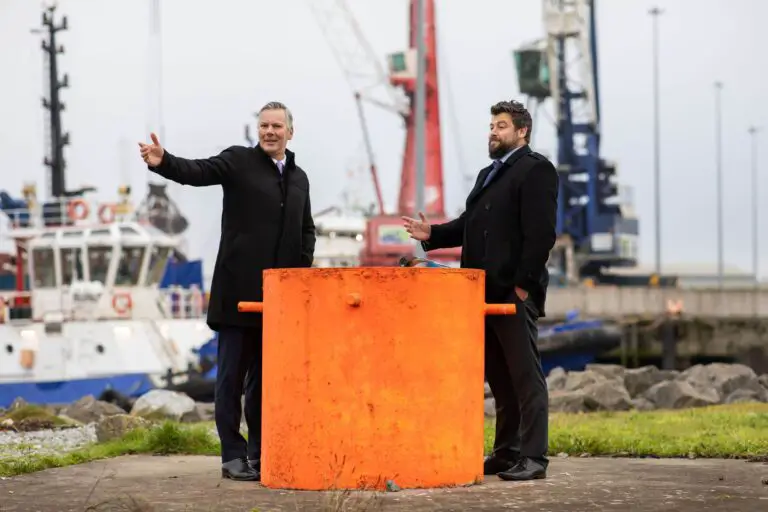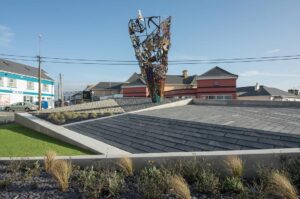*Pat Keating, CEO of Shannon Foynes Port and Paul Doherty, MD Gavin & Doherty Geosolutions’ pictured at Foynes Port | PICTURE: Sean Curtin
An unprecedented renewable energy opportunity for Ireland, the Shannon Estuary and the west coast of Clare has been unveiled in a new major study.
The Offshore Wind Potential Study commissioned by Shannon Foynes Port Company – by specialist geotechnical engineering consultancy Gavin & Doherty Geosolutions Ltd. (GDG) identifies the potential, through capitalising on our unique wind resource and deep-water port, to turn the State into an exporter of energy and generate unprecedented job creation in the process.
As the floating wind sector is currently in its infancy, there is no well-established supply chain and this represents an opportunity for Ireland to be first movers in the floating wind sector, the report states. The report estimates €12billion investment into the Estuary by 2050 under a medium growth scenario and without including export potential to other markets.
The opportunity is a confluence of the emergence of floating offshore wind technology as the biggest growth area for renewables globally, the Irish west coast – including off Co. Clare – having among the best wind resources in the world and the unrivalled deep waters of the Shannon Estuary – a key asset and component for the manufacturing and industrial ecosystem necessary to support the global scale floating offshore wind farms
The report, which also focuses on the Moneypoint facility, estimates that the available wind resource can generate up to 70GW of floating offshore wind energy and identifies not alone the export opportunity from excess electricity generated but also for green hydrogen produced from the offshore wind farm sites.
It finds that Shannon Foynes is best placed to service the future offshore floating wind market. This is due to the proximity to resource and market; availability of the deepest watercourse in Ireland and one of the deepest and most sheltered estuaries in the world; extensive future landbank availability; and the existence of Shannon Foynes Port Company as a statutory authority with National Tier 1 port status and European Commission, Trans European Transport Network (TEN-T) core corridor status on North/South and East/West corridors and existing 1.6 GW connectivity to our own national grid.
“Offshore Floating Wind is rapidly expanding and therefore now is the time to capture the potential from this early-stage sector. Given the timelines to develop the required infrastructure, now is the time to commit the investment and ensure Ireland Inc. capitalises on the global opportunity as first movers in this exciting space. Shannon Foynes Port is the vehicle to maximise the benefits to Ireland Inc. from the floating wind market,” the report states.
There is potential to create between 10,000 – 20,000 jobs in manufacturing and a further 10,000 industry jobs arising from four distinct supply chain opportunities – Manufacturing, Staging and Installation, Operations and Maintenance by 2050 according to the report.
Manufacturing could also extend to the preparation and export of component parts further afield to the East coast of USA and into European developments, both onshore and offshore.
The study, which was carried out this year, found that the Shannon Estuary is best placed to service the future offshore floating wind market, both the domestic market and as a global exporter of energy and technology. It is, the report states, no surprise that the first Offshore Wind Farm sites in Ireland were all situated on the east coast, as they have fixed foundations. However, as the offshore floating wind technology becomes more efficient and the associated supply chain develops, the west coast of Ireland will become much more favourable. “The total potential capacity on the West coast dwarfs the East coast opportunity,” it adds. “To facilitate taking a lead in the global market, Ireland needs to apply significant investment in research & development to solve this market barrier along with looking to reduce the cost of floating wind technology,” it states.
To this end, the planned International centre of Excellence for Floating offshore wind and its connectivity to our university’s offers a very rare opportunity also.
Among the individual challenges that need to be overcome are lack of an overarching Government policy identifying the export opportunity, weaknesses in the planning and consenting process, the construction of new port infrastructure, lack of an integrated approach and other competing countries are getting a head start, such as Scotland, Norway, Denmark, Holland, Belgium, France and Portugal.
Welcoming the report, Pat Keating, CEO of Shannon Foynes Port said: “This report quantifies for the first time the unique floating offshore wind opportunity that exists for Ireland and not just for this region. The mix of our world-class wind resources, the natural infrastructure here for a global manufacturing and industry base and climate change adds up to what is an unprecedented opportunity that we must capitalise on. There is already significant interest in this from global energy players and we would anticipate generating a gigawatt of energy by the turn of the next decade. This would very much be a phased programme rivalling anything on an international scale but will transition Ireland to a global renewable energy leader. It will deliver our own energy requirements through renewable resources, replacing fossil fuels in the long term, but will also see Ireland become becoming a significant exporter of energy into the bargain.”
Helen Downes, CEO of Shannon Chamber observed, “From a business perspective for the region and also the nation, this is an unprecedented opportunity that we must take. The opportunity is as big as 30,000 jobs to up to 2050 and it’s also going to address our climate change challenges, which is a huge emphasis from businesses across the region. And really now it’s up to government nationally to actually make this happen.”
Chairman of Shannon Foynes Port David McGarry added: “A Danish study has recently calculated that every gigawatt of offshore renewable energy produced will support up to 14,600 jobs in the Danish economy. The calculations are easy to do from there and even if we target only half of the estimated 70GW potential off the West Coast, there’s a huge economic and jobs bounce from this as well. This can be transformational for the Irish economy and our environment. Floating technologies are relatively new in the offshore renewables sector and, coupled with the Atlantic’s mean wind speeds of 14m/s, we have global first mover advantage with this”.


















